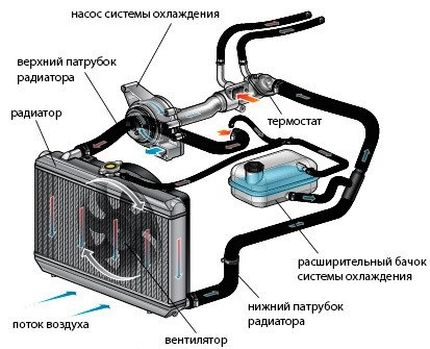
How to Diagnose a Cooling System Problem
Content
- Part 1 of 9: Study Your Car's Cooling System
- Part 2 of 9: Defining the Problem
- Part 3 of 9: Check the thermostat for a problem
- Part 4 of 9: Check for clogged radiator
- Part 5 of 9: Checking the Cooling System for Leaks
- Part 6 of 9: Check the airtight cover of the cooling system
- Part 7 of 9: Check for a faulty water pump
- Part 8 of 9: Check if the radiator cooling fan is defective
- Part 9 of 9. Check for a defective cylinder head gasket or internal problems
You may be driving down the road or sitting at a traffic light when you first notice that the temperature gauge in your car is starting to rise. If you let it run long enough, you may notice steam coming from under the hood, indicating...
You may be driving down the road or sitting at a traffic light when you first notice that the temperature gauge in your car is starting to rise. If you let it run long enough, you may notice steam coming out from under the hood, indicating that the engine is overheating.
Problems with the cooling system can begin at any time and always occur at the most inopportune moment.
If you feel like your car has a problem with its cooling system, knowing what to look for can help you identify the problem and even fix it yourself.
Part 1 of 9: Study Your Car's Cooling System
Your vehicle's cooling system is designed to keep the engine at a constant temperature. It keeps the engine from running too hot or too cold after it has warmed up.
The cooling system consists of several main components, each of which performs its task. Each of the following components is required to maintain the correct engine temperature.
Part 2 of 9: Defining the Problem
When your car starts normally in cold weather, and if the temperature rises to overheating and doesn't cool down until the car has been sitting for a while, there may be several different problems with your car.
If any of the components fail, a number of problems can arise. Knowing the symptoms caused by each part can help you identify the problem.
Part 3 of 9: Check the thermostat for a problem
Necessary materials
- Coolant Coloring Kit
- Cooling system pressure tester
- Infrared temperature gun
A faulty thermostat is the most common cause of overheating. If it does not open and close properly, it should be replaced by a certified mechanic, such as from AvtoTachki.
Step 1: Warm up the engine. Start the car and let the engine warm up.
Step 2 Locate the radiator hoses.. Open the hood and locate the upper and lower radiator hoses on the vehicle.
Step 3: Check the temperature of the radiator hoses. When the engine starts to overheat, use a temperature gun and check the temperature of both radiator hoses.
If you think the radiator hoses need to be replaced, ask a certified technician, such as AvtoTachki, to do it for you.
Continue to monitor the temperature of both hoses, if the engine starts to overheat and both radiator hoses are cold or only one is hot, then the thermostat needs to be replaced.
Part 4 of 9: Check for clogged radiator
When the radiator is clogged internally, it restricts the flow of coolant. If it becomes clogged on the outside, it will restrict airflow through the radiator and cause overheating.
Step 1: Let the engine cool down. Park the car, let the engine cool down and open the hood.
Step 2 Inspect the inside of the radiator.. Remove the radiator cap from the radiator and check for debris inside the radiator.
Step 3: Check for External Blockages. Inspect the front of the radiator and look for debris clogging the outside of the radiator.
If the radiator is clogged from the inside, it must be replaced. If it is clogged on the outside, it can usually be cleared out with compressed air or a garden hose.
Part 5 of 9: Checking the Cooling System for Leaks
A leak in the cooling system will cause the engine to overheat. Any leak must be repaired to prevent serious engine damage.
Necessary materials
- Coolant Coloring Kit
- Cooling system pressure tester
Step 1: Let the engine cool down. Park the car and let the engine cool down.
Step 2. Remove the airtight cover of the cooling system.. Remove the pressure cap from the cooling system and set it aside.
Step 3: Apply pressure. Using a cooling system pressure tester, follow the manufacturer's instructions and pressurize the cooling system.
- A warning: The maximum pressure you must apply is the pressure indicated on the radiator cap.
Step 4: Check all components for leaks. When pressurizing the system, check all components of the cooling system for leaks.
Step 5: Add coolant dye to the system. If no leak is found with a pressure tester, remove the tester and add coolant dye to the cooling system.
Step 6: Warm up the engine. Replace the radiator cap and start the engine.
Step 7. Check for dye leakage.. Let the engine run for a while before checking for traces of dye that indicate a leak.
- Functions: If the leak is slow enough, you may need to drive the car for a few days before checking for traces of dye.
Part 6 of 9: Check the airtight cover of the cooling system
Required material
- Cooling system pressure tester
When the sealed cap does not hold the proper pressure, the coolant boils, causing the engine to overheat.
Step 1: Let the engine cool down. Park the car and let the engine cool down.
Step 2. Remove the airtight cover of the cooling system.. Unscrew and remove the cooling system cover and set it aside.
Step 3: Check the lid. Using a cooling system pressure tester, check the cap and see if it can withstand the pressure indicated on the cap. If it does not hold pressure, it must be replaced.
If you are uncomfortable crimping the radiator cap yourself, contact a certified mechanic, for example, from AvtoTachki, who will crimp for you.
Part 7 of 9: Check for a faulty water pump
If the water pump fails, coolant will not circulate through the engine and radiator, causing the engine to overheat.
Step 1: Let the engine cool down. Park the car and let the engine cool down.
Step 2. Remove the airtight cover of the cooling system.. Unscrew and remove the cooling system cover and set it aside.
Step 3: Check if the coolant is circulating. Start the engine. When the engine is warm, visually observe the coolant in the cooling system to make sure it is circulating.
- Functions: If the coolant is not circulating, a new water pump may be needed. Checking the water pump should only be done after you are sure that the thermostat is defective.
Step 4: Inspect the water pump. A faulty water pump sometimes shows signs of a leak, such as moisture or dry white or green marks on it.
Part 8 of 9: Check if the radiator cooling fan is defective
If the cooling fan is not running, the engine will overheat when the vehicle is not moving and there is no air flow through the radiator.
Step 1: Locate the radiator cooling fan.. Park the car and apply the parking brake.
Open the hood and locate the radiator cooling fan. It can be an electric fan or a motor-driven mechanical fan.
Step 2: Warm up the engine. Start the car and let the engine run until it starts to warm up.
Step 3: Check the cooling fan. When the engine starts to warm up above normal operating temperature, keep an eye on the cooling fan. If the electric cooling fan does not turn on, or if the mechanical fan does not rotate at a high speed, then the problem is with its operation.
If your mechanical fan is not working, you need to replace the fan clutch. If you have an electric cooling fan, you need to diagnose the circuit before replacing the fan.
Part 9 of 9. Check for a defective cylinder head gasket or internal problems
The most serious problems with the cooling system are related to internal engine problems. This usually happens when another part of the cooling system fails, causing the engine to overheat.
Necessary materials
- Block Test Suite
Step 1: Let the engine cool down. Park the car and open the hood. Let the engine cool down enough to remove the radiator cap.
Step 2: Install the Block Tester. With the radiator cap removed, install the Tester according to the manufacturer's specifications.
Step 3: Observe the Block Tester. Start the engine and watch the unit tester indicate the presence of combustion products in the cooling system.
If your test shows that combustion products are entering the cooling system, then the engine needs to be disassembled to determine the severity of the problem.
Most cooling system problems can be identified by performing one or more of these tests. Some issues will require further testing with other diagnostic tools.
Once you find a defective part, replace it as soon as possible. If you are not comfortable doing these tests yourself, find a certified mechanic, such as from AvtoTachki, to check the cooling system for you.

